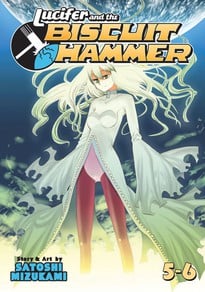Review
by Nick Creamer,Lucifer and the Biscuit Hammer
GN 5-6
| Synopsis: |  |
||
Six golems have been defeated, but the Beast Knights and their Princess Samidare aren't getting any time to rest. An attempted beach trip gets swiftly interrupted by golem seven and its mage master Animus in a volume full of further trials for our brave heroes. What will Samidare do when her mother comes home, and for that matter, what will she do when her strange destiny manifests itself as an actual person? And how might the Knights cope with the loss of one of their own, someone all these warriors have come to know? Things are starting to look pretty dire for the Beast Knights in the third collection of Lucifer and the Biscuit Hammer. |
|||
| Review: | |||
From the first collection to the second, Lucifer and the Biscuit Hammer ramped up significantly in storytelling ambition and execution. A narrow story unfolded into an ambitious ensemble one, and compelling themes regarding family, adulthood, and the value of a life began to resound across the entirety of the cast. In this third collection, I'm happy to report that trend has only continued - Biscuit Hammer is better than it's ever been, a passionate and consistently engaging drama that seems to be getting more heartfelt and confidently composed by the chapter. The collection starts off on its lightest note, as all of the Beast Knights gather together to train at… the beach. This is just the first of the volume's many misdirects, though, as lighthearted beach time is swiftly interrupted by the Mage Animus and his newest seven-eyed creation. The fight that follows is perhaps Biscuit Hammer's first legitimately visually engaging battle, featuring a great sense of visual momentum across panels, greater clarity in actually conveying the give and take of combat, and even a wonderful two-page spread of Samidare treating Animus to a seismic punch. This visual upgrade is a trend that continues across the collection. There are still some wonky anatomy issues throughout, and I'm still not sure if Satoshi Mizukami has ever seen an actual horse before, but overall the art undergoes a consistent upgrade all throughout these volumes. Not only are the characters more consistently drawn (they possibly have bones now!) and overall compositions more dynamic, but the structural understanding of panel flow seems dramatically improved from earlier chapters. Visual beats follow each other with a real sense of momentum, keeping energy high throughout the story's big action setpieces. The manga isn't at the point where I'd highlight Biscuit Hammer as a visual accomplishment, but the art certainly no longer holds the story down, and often complements it. The fights in this collection are actually their own reward, and not just handy visual depictions of various thematic shifts and character moments. Not that they stop being relevant to the characters and themes, either. The story also keeps a brisk pace throughout these volumes; with all of the Beast Knights introduced and their general motives established, the story is free to complicate their relationships and challenge their assumptions about themselves and each other. An arc early on reengages with the question of what our families mean and how they define us, as the return of Samidare's mother prompts her to retreat into herself. This conflict is resolved when Yuuhi finally succeeds in domain-leaping across the river, not to defeat some new golem, but simply to ask Samidare to meet with her family. That choice is neatly reflective of Biscuit Hammer's overall priorities - mystical battles are nice and all, but that's a lot less interesting than how we treat the people we love, and making the most of our time in an uncertain world. That uncertainty is brought the forefront in the volume's second half, as the death of one of the knights causes all the heroes to reassess their position and convictions. In Biscuit Hammer's second collection, characters kept returning to the value of a life, and the importance of being able to “die smiling, without regrets.” That goal is never treated as an easy thing by this story, and is forever complicated by caveats and tragedy. “Smile like being a grown-up is fun,” Yuuhi asks Samidare's sister, gracefully tying together the importance of inspiring the people you love and the melancholy of adulthood. And when he's congratulated for his “strength” in keeping up a brave face in response to tragedy, the Cat Knight responds with “there's no such thing as a strong person.” The ways these characters lean on each other is made clear in the smart mix of whimsical downtime and high-stakes drama, and the writing elevates the story both through its consistent subversion of cliche and piercing individual lines. Lucifer and the Biscuit Hammer is shaping up to be something truly special. |
| Grade: | |||
|
Overall : A-
Story : A
Art : B
+ Writing and art only continue to improve; quirky sense of humor is maintained even as the story poignantly engages with deeper questions. |
|||
| discuss this in the forum (5 posts) | | |||
| Production Info: | ||
|
Full encyclopedia details about Release information about |
||